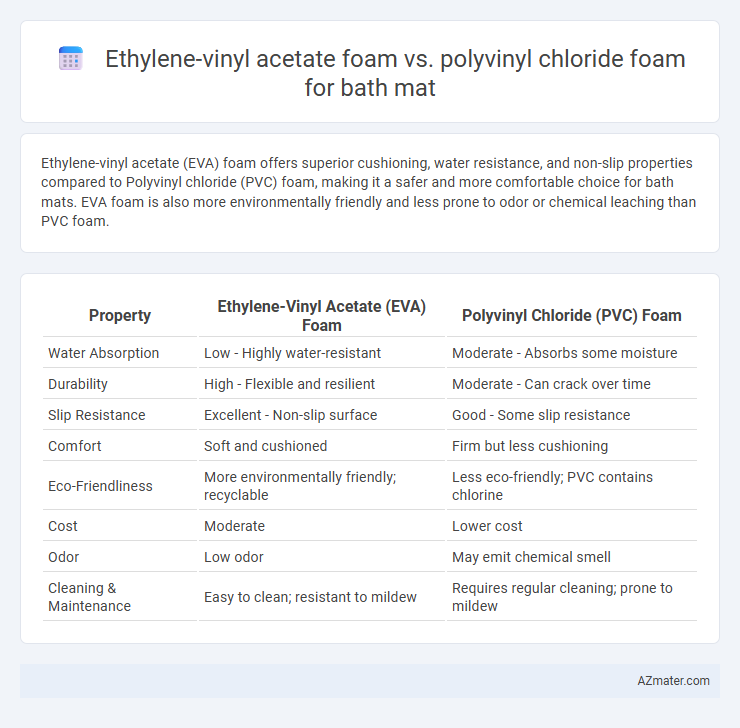Ethylene-vinyl acetate (EVA) foam offers superior cushioning, water resistance, and non-slip properties compared to Polyvinyl chloride (PVC) foam, making it a safer and more comfortable choice for bath mats. EVA foam is also more environmentally friendly and less prone to odor or chemical leaching than PVC foam.
Table of Comparison
| Property | Ethylene-Vinyl Acetate (EVA) Foam | Polyvinyl Chloride (PVC) Foam |
|---|---|---|
| Water Absorption | Low - Highly water-resistant | Moderate - Absorbs some moisture |
| Durability | High - Flexible and resilient | Moderate - Can crack over time |
| Slip Resistance | Excellent - Non-slip surface | Good - Some slip resistance |
| Comfort | Soft and cushioned | Firm but less cushioning |
| Eco-Friendliness | More environmentally friendly; recyclable | Less eco-friendly; PVC contains chlorine |
| Cost | Moderate | Lower cost |
| Odor | Low odor | May emit chemical smell |
| Cleaning & Maintenance | Easy to clean; resistant to mildew | Requires regular cleaning; prone to mildew |
Introduction to EVA and PVC Foams
Ethylene-vinyl acetate (EVA) foam is a soft, flexible material known for its excellent cushioning, water resistance, and non-toxic properties, making it a popular choice for bath mats. Polyvinyl chloride (PVC) foam offers durability and chemical resistance, often featuring a denser structure that provides sturdiness and support in wet environments. Both EVA and PVC foams are lightweight and easy to clean, with EVA foam typically favored for comfort and PVC foam valued for its robust and long-lasting performance in bathroom applications.
Material Composition: EVA vs PVC
Ethylene-vinyl acetate (EVA) foam consists of a copolymer combining ethylene and vinyl acetate, offering superior flexibility, softness, and water resistance ideal for bath mats. Polyvinyl chloride (PVC) foam is composed of polymerized vinyl chloride with added plasticizers, providing higher durability and chemical resistance but with less elasticity compared to EVA. The EVA foam's non-toxic, odorless nature makes it preferable for bathroom use, while PVC foam's robustness suits heavy-duty applications yet can emit volatile compounds.
Water Resistance and Absorbency
Ethylene-vinyl acetate (EVA) foam offers superior water resistance compared to polyvinyl chloride (PVC) foam, making it ideal for bath mats that require quick drying and minimal water retention. EVA foam's closed-cell structure prevents water absorption, ensuring a dry and slip-resistant surface, while PVC foam tends to absorb more moisture and may retain water longer. For bath mats, EVA foam provides enhanced durability and hygiene benefits by resisting mold and mildew buildup due to its lower absorbency and better water repellency.
Comfort and Cushioning Properties
Ethylene-vinyl acetate (EVA) foam offers superior cushioning and softness, making it ideal for bath mats that require enhanced comfort and shock absorption underfoot. Polyvinyl chloride (PVC) foam provides firmer support but lacks the same level of flexibility and plushness found in EVA, resulting in a less cushioned feel. EVA's lightweight nature and resilience contribute to long-lasting comfort, while PVC foam tends to compress more over time, reducing its cushioning effectiveness.
Durability and Longevity
Ethylene-vinyl acetate (EVA) foam exhibits superior durability and longevity for bath mats due to its excellent resistance to cracking, UV exposure, and water absorption, which prevents degradation over time. Polyvinyl chloride (PVC) foam, while cost-effective, tends to degrade faster under constant moisture and physical abrasion, leading to brittleness and loss of cushioning. EVA foam's enhanced structural integrity and resilience make it the preferred choice for bath mats requiring extended lifespan and sustained performance.
Safety and Non-Toxicity Comparison
Ethylene-vinyl acetate (EVA) foam offers superior safety and non-toxicity for bath mats due to its low chemical emission and hypoallergenic properties, making it ideal for sensitive skin and reducing health risks. Polyvinyl chloride (PVC) foam may release harmful phthalates and volatile organic compounds (VOCs), posing potential health hazards and environmental concerns during prolonged exposure. EVA foam's inert composition and resistance to microbial growth further enhance its safety profile compared to PVC foam in wet and humid bathroom environments.
Anti-Slip Performance in Wet Conditions
Ethylene-vinyl acetate (EVA) foam offers superior anti-slip performance in wet conditions due to its closed-cell structure, which provides excellent water resistance and cushioning, reducing slip risks in bathroom settings. Polyvinyl chloride (PVC) foam, while durable and resistant to water absorption, often exhibits lower friction coefficients when wet, potentially leading to decreased grip on smooth surfaces. Selecting EVA foam bath mats enhances safety by maintaining stable traction and preventing slips in moist environments.
Maintenance and Cleaning Ease
Ethylene-vinyl acetate (EVA) foam bath mats offer superior maintenance and cleaning ease due to their closed-cell structure, which resists water absorption and inhibits mold and mildew growth. Polyvinyl chloride (PVC) foam bath mats, while durable, tend to absorb moisture more readily, requiring frequent thorough drying to prevent bacterial buildup. EVA foam mats can be easily cleaned with mild soap and water, maintaining their shape and hygiene longer than PVC counterparts, which may degrade or become sticky with repeated exposure to cleaning agents.
Environmental Impact and Recyclability
Ethylene-vinyl acetate (EVA) foam for bath mats offers superior environmental benefits due to its lower toxicity and higher potential for recycling compared to polyvinyl chloride (PVC) foam. PVC foam generates harmful dioxins during production and disposal, contributing to soil and water pollution, while EVA foam decomposes more cleanly and is more easily reprocessed into new products. Choosing EVA foam reduces environmental impact and enhances sustainability through greater recyclability and lower pollutant emissions.
Cost Efficiency and Market Availability
Ethylene-vinyl acetate (EVA) foam offers superior cost efficiency for bath mats due to its lower production costs and widespread market availability, making it a preferred choice for budget-conscious consumers. Polyvinyl chloride (PVC) foam, while typically pricier due to more complex processing, provides enhanced durability and resistance but is less commonly stocked by retailers. The abundance of EVA foam in the market ensures easier sourcing and quicker supply chains, which further reduces overall expenses compared to PVC foam options.

Infographic: Ethylene-vinyl acetate foam vs Polyvinyl chloride foam for Bath mat
 azmater.com
azmater.com